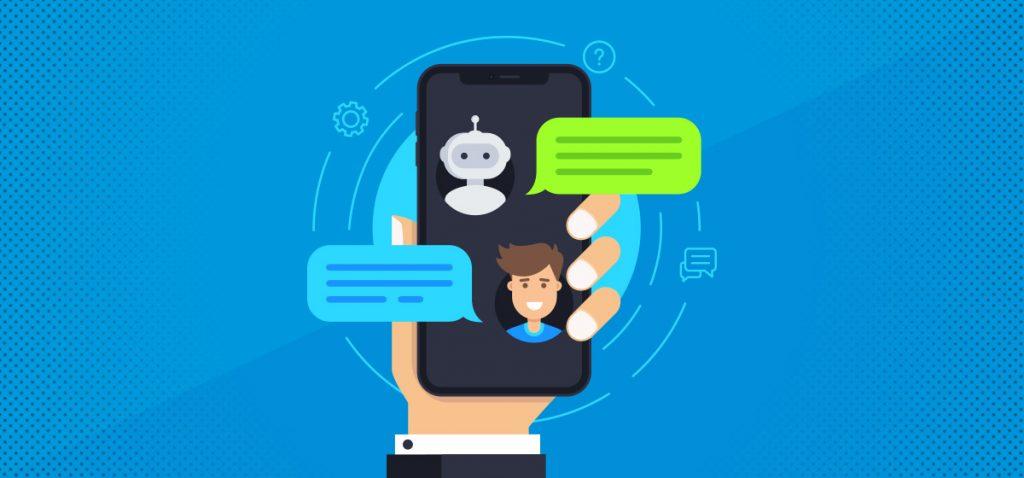
Top 7 Chatbot Marketing Strategies for 2019
Modern marketing strategies are becoming more automated and sophisticated every day.
Marketing messaging has been automated for a long time…
…but now that includes real time automated messaging.
Companies can have automated robotic conversations with customers that move users through the funnel and pass them off to a human if needed at the right time.
White the word “bot” can conjure up cold images of impersonal interaction, modern chatbots are actually making the customer journey more personalized than ever before.
Not only does it make the customer journey more personalized but it makes marketing platform integrations even more seamless than before.
Automated conversations can follow users from your website to various social media platforms without missing a beat.
What Are Chatbots?
Chatbots are automated messaging services that integrate with websites and social media platforms.
They simulate a human conversation and interpret basic messaging cues to funnel users either to another more segment question or to specific digital assets such as products or articles.
Chatbots are now used to perform basic to complex audience segmentation, list building, and website personalization.
How Do Chatbots Work?
In general chatbots either work through rules-based messaging or through artificial intelligence.
Rule-based chatbots are more limited in their reach and their ability to respond to various communication cues.
These chatbots are great for basic audience segmentation, and funneling users into certain product or educational assets that would be of interest to a user.
Artificial intelligence based chatbots are much more complex and have a component of machine learning.
AI based chatbots have the ability to learn from the interaction of web users and grow their ability to respond as time goes on.
Chatbot Marketing Strategies
Chatbots are a highly efficient tool for digital marketing and have many useful purposes for marketers. Here are 7 chatbot strategies to consider in your digital marketing:
1. Chatbots to Personalize the Website Experience
Web users prefer personalized experiences.
A personalized experience gets users where they want quicker and it serves them more relevant content.
Not only does personalization create a better user experience…
…it brings more repeat traffic and builds customer loyalty.
Examples of chatbot personalization include making customized product recommendations based on chatbot messenger cues.
Or a chatbot that automatically sends articles based on topics that it has learned you are interested in.
2. Welcome website visitors
Like it or not, there is a reason that Walmart has a long history of ‘Walmart greeters’.
Greeting customers as they enter your store gives an instantly personalized touchpoint.
If customers need help, have a question, or are looking for a specific product, they have an opportunity in their first moments to get pointed in the right direction with chatbots.
Chatbots are a modern and relevant way to welcome customers into your online store, your website’s design.
Many website visitors will never click on a chatbot welcome message, but customers who are ready to move down the funnel will go straight to the dialog box to ask a question, or get pointed toward their area of interest.
Without a welcome message, the opportunity to provide added value gets missed and leaves customers on their own to find what they’re looking for.
3. Generate and funnel sales leads
Chatbots are a great way to generate leads and funnel to the sales team.
This works best when the sales team is able to jump into messenger sessions in real time as needed.
The chatbot asks questions, segments users, and identifies when a user is ready to make a purchase.
Then the IRL sales person can seamlessly jump in, without the user noticing any difference and finish the sale.
This is a great way to make sure that leads are helped at the very moment they become qualified and helps sales reps prioritize their time only on customers that are ready to make a purchasing decision.
NOTE: We wrote a step-by-step guide to Doubling Your Leads in 30 Days. If you’re serious about generating leads online, this is the place to start. It’s the exact process we use to convert a massive number of leads for our clients.
4. Internal marketing with Slack
Slack has an ever growing list of apps and integrations and chatbots are no exception.
There is a nearly endless way to use chatbots for internal marketing in Slack.
Here are a few of our fun favorites
Lunchtrain: No longer does a call for a group lunch have to spam everyone’s general slack channel. Lunchtrain sends a direct message to all users, invites them to join the group lunch, reminds them when it’s time to leave and sends the coordinator an update of who is coming.
Meekan Scheduling Robot: Finding a time for an entire team to have a meeting can take forever when you do it manually. Enter Meekan: a chatbot that can schedule perfect meetings with your Slack team in seconds.
BirthdayBot: Who can remember every person’s birthday? BirthdayBot can! It is an app designed for Slack that automatically posts original birthday messages in your team chat.
Timebot: This Slackbot helps teams to manage time-off requests, vacations, and absences. This saves time for management organizing requests in a single location and makes it easier for employees to see how many days off they have left, how many people are OOO at a given time, and can be coordinated without ever leaving Slack.
5. Build retargeting lists with chatbots
Users who engage with your chatbots become users that you can retarget.
Building customer trust depends on being able to build real time customer relationships and being able to engage with them where they’re spending their time.
There are several ways to use chatbots for building retargeting lists.
Most chatbots will integrate with your CRM and build audience profiles for every user. When a user engages with your chatbot, they are segmented and recognized when they return to your website.
You can pick up the conversation where you left off or make a product recommendation based on what was learned from them in previous sessions.
Facebook messenger integration is another way to use chatbots for retargeting lists.
Your chatbot service usually has a feature that allows you to send the conversation over to Facebook Messenger.
If a user then sends a message back to you in Facebook messenger, you can build a retargeting audience.
These audiences can become as important as pixelated audiences because they are flagged as having an interest in your business and you can send targeted Facebook messages to them that you otherwise wouldn’t be able to send.
6. Sell products with chatbots
A chatbot conversation can become a mini shopping page.
Rather than browsing an entire online catalog of products, a chatbot can ask questions that lead to product recommendations.
Users can then add products directly to their carts and talk with the chatbot about other related products that they might be interested in.
Traditionally, customers have had to shop around to find products that they’re interested in…
…but artificial intelligence is now making it easier for customers to discover new products even without touching the shopping page of a website.
7. Get user demographics
On a traditional survey, customers may not be willing to share demographic information.
But a chatbot has a more personal feel.
If a user is already engaging with a messenger bot to get help finding a solution, they’re more likely to answer some demographic questions that can be integrated with their CRM profile.
Because of the casual setting on a dialog window and the trust built through conversations, users may be more likely to share personal information.
The more personal information you’re able to gather about a customer, the better you can market to them with highly personalized promotions and products.
Getting Started With Chatbot Marketing Strategies
Chatbots offer new ways to build relationships with customers.
They integrate with your CRM, personalize the customer experience, and efficiently convert users into leads and, ultimately, customers.
If you’re looking to get started with chatbot marketing, first ask yourself, “what do I need my chatbot to accomplish?”
There are my strategies for chatbot marketing and the chatbot you choose will depend on your end goal.
What are your experiences with chatbot marketing?













Tell us what you think
Share your thoughts here in the comments! Have a burning question or feedback about the topic? Let’s keep the conversation going.